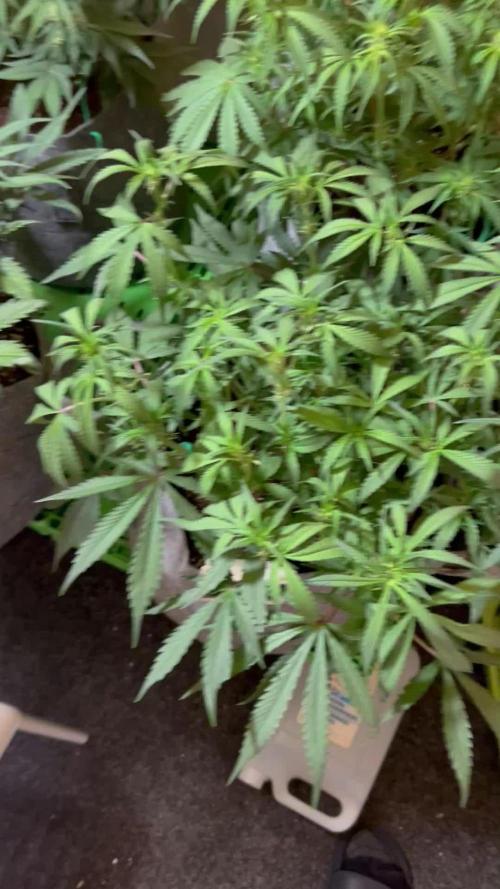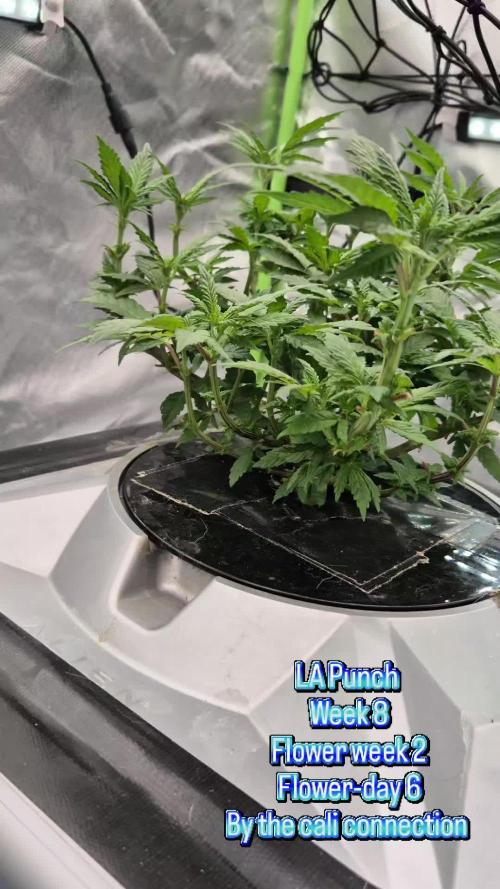The Grow Awards 2026 🏆 































Likes
44
Share


@SooSan
Follow
12/12 + 35 jours
Vu qu’il y a 16 plantes mais que sur growdiaries on ne peut mettre que 8 variétés j'ai divisé en 2 diaries pour le bas de la tente
1️⃣
🏠 90x60x90
☀️ FC-E 4800 => puissance a 20%
🍁
1x Black Bomb / Philosopher Seed
2x Amnesia Lemon / PEV Seeds
1x Blueberry / PEV Seeds
1x Blueberry / 00 Seeds
1x Wappa / Paradise Seed
1x Dark Phoenix / Green House Seed
1x Quick Sherbet / Exotic Seeds
1x Mango Cream / Exotic Seeds
1x Banana Frosting / Sensi Seed
1x Hindu Kush / Sensi Seed
3x Fast Mix / Sweet Seed
📎 https://growdiaries.com/diaries/122084-grow-journal-by-soosan
📎https://growdiaries.com/diaries/124052-grow-journal-by-soosan
2️⃣
🏠 30x60x50
☀️TS1000 => puissance a 50%
🍁 4x Quick Sherbet - Exotic Seed
📎 https://growdiaries.com/diaries/122080-grow-journal-by-soosan
Likes
18
Share


@Michigangrown95
Follow
The Bruce bangers are huge and falling under there own weight but no complaints here. They are starting to produce alot of trycomes and put on weight. I'm feeding them 600 ppm every 2 days and they could still use more just worried about burning but so far they are just hungry. I harvested the white widow girl they are hanging and will give a final harvest dry weight when they are dry. 2 of the widows got some good purple but all are fire. 🔥 thanks for looking happy growing and god bless.!
Likes
17
Share


@NuttyYeti
Follow
She was getting a little pale so I added a bunch on nutes last week to see if it would help. Doesn't seem like it did so I tested the pH and it was pretty high. Added some pH Down this week and got the pH down to 6. She got a good dose of nutes after that. We will see how the week goes. Hopefully next week she'll be a lot happier. 💚
Likes
15
Share


@pifflestikkz
Follow
Day 1
30/12/24 Monday evening.
Started the seed off in de-chlorinated tap water and calmag 3ml to 5L pH 6.4.
I will use this water for the rest of the week as sprays and transfer water.
Day. 2
31/12/24 Tuesday
Seed has sunk 🙌
Transferred now to paper towel, sprayed with same water. Covered. Left in cupboard 24hrs untill tap root emerges ✌️
Day 3 Wednesday
01/01/25 nothing yet so left for a further 24 hours.
Day 4
02/01/25 Thursday
Tap root just emerged! Seed only just cracked. Will leave a further 24hrs for a sustainable tap root.
Day 5
03/01/25 Friday
Tap root has reach 2/3cm and now been potted up in a 1L pot with cannaterra pro, added perlite, added cococoir, and dynomyco, all watered yesterday to dampen off. . Sprayed top soils today to settle in seeds.
Day 6
04/01/25 Saturday
Seed has emerged to top of soil level 😁
Moved all seedlings into the auto tent so they can catch the 600w dual hps.
Day 7
05/01/25 Sunday
The seedlings are here 🙌
She made it through the first week, onwards and upwards 🚀💚
Seed casing will pop tonight I think.
Light spray with de-chlorinated tap water and calmag. Covered with dome.
Picture update 📸💚
Likes
10
Share


@stoneyroneyjr
Follow
Been too busy to update the last few weeks, but they’re surviving longer then I expected. When I received my new light I did not take in consideration of the heat output and within the first night of use the tent reached a scorching 88 degrees
Likes
82
Share


@BigBadLion
Follow
Hey guys!
Sorry for the big delay since my previous grow! Right now I'm growing some babies from Royal Queen Seeds! Kali Dog! 😃
The first week was calm! The babies broke out from their shells rather fast and two babies grew out of their jiffy pods rather fast! Also, since the strain is Kali Dog I decided to name each of the plants with a different dog name! I'm still unsure about the names but the first two are called Roko and Max!
For the first time I also noticed the first buds looked... different? You'll be able to see them in the photos tho... and once again two of my babies are suffering from helmet head 😰 But eh, I'm used to it. Gladly it's an easy error to fix.
I'll try to make a longer timelapse (these were bad!) but I didn't know my camera battery wasn't enough for long sessions 😝
Anyway, thanks for reading! See you all next week! 👋
Likes
10
Share


@SkunkyDog
Follow
Hallo zusammen 🤙.
Sie wächst sehr schön und macht keine Probleme.
Nächste Woche kommt sie unters Messer 🤤🤙
Likes
4
Share


@jdean88
Follow
All flowering nice now the og has stretched a lot with the strawberry and blue dream fod to like the last phenos I had but never the less the smell is amazing can’t wait to see them finish and enjoy a lovely smoke.the gorilla melon il be letting veg till mid November then il flip it she should fill the tent by then
Likes
4
Share


@QixxGrows
Follow
I might switch the lights in the next days. Depending on her growth.
Day44: Added some water and moved the camera a little further away.
Day45: She felt lonely, so I got her a friend... Theobroma Cacao. New seedling that needs the warmth + humidity. Hopefully surviving winter.
Day46: I decided to take some zoomed in stills of her. To show off her beauty. The purpling of the branches really make this lady something special. In some of the shots it might look like her leaves are yellowing, but it's just the angle of the light. You can see on the photo that I took from the top, that all leaves are a healthy dark green. At least I now have proof that she's a lady. She's short and stubby, but I'm not really growing for amount. I just neeed 50g, after all (hehe)
Day47: She grew like a demon overnight. I'll check the height tomorrow.
Likes
7
Share


@RBG
Follow
Week 8
Flower week 2
Flower-day 5
26/10/2025
Finally feeling good again!
Kept the same nutrient mix almost the same, have had to use some others just to get by until more rock up 🙃
Floramax Veg 1: 1000ml
Floramax Rezin: 400ml
Floramax Organabud: 400ml
Floramax Flowering Enhancer: 400ml
Cyclo Platinum Silica: 200ml
ISN Cal-Mag: 400ml (still waiting on my main one to be delivered, so using what’s left of this)
Green Planet Massive Bloom: 200ml
Green Planet Bud Booster: 4 scoops (30ml each)
Sleeps with the Fishez: 100ml — used some hydrogen peroxide today while waiting for the next batch to arrive next week
I’ve been looking into a flushing additive called New Millennium Winter Frost for a nice clean finish.
Pistils finally popped up yesterday on a few of the top sites! Should start seeing some solid stretch from LA punch soon, guessing around 30 to 40cm at least, who really knows right now 🤷♂️
I’m letting her do her thing and reach up into the net for now. If she starts getting crowded before the end of week 3, I’ll kick off some early defoliation.
Also got two AC Infinity IonBeam S11 lights set up sitting about level with the top colas. I’m aiming the light to hit the middle and lower sections instead of blasting the tops directly, trying to get that nice even coverage.
Still debating whether I even need to scrog this run, but a few people keep telling me to give it a go to see the difference, I guess only one way to tell 🙌
Processing
Likes
24
Share


@Cogollo_eu
Follow
**Encontrarás la traducción a español al final de la descripción**
From/Desde: 23/09/19 || To/Hasta: 29/09/19
From day/Desde día: 63 || To day/Hasta día: 69
If you like this week, please hit a like, it costs you nothing! 👊. Thanks in advance 😉!
-----IMAGES & VIDEOS-----
I'm sorry to not having more Alice timelapses, the tent is too small to record some decent videos due to Alice size, a think that I must have in mind for upcoming grows.
-----WEEK SUMMARY-----
One week more that Alice overpass my expectations, I'm really not having any time to do nothing to her, but she's still beauty. Those buds are looking amazing on it's start, I can't wait more to see those full buds formed.
I'm not vey proud of using mineral s#@ts, but i already tested it and results are really appreciable. Anyway I'm not using it in excess, just the day 29 and probably at October 8, just 2 applications. I'm also using Bloombastic, Organic PK Booster & Overdrive.
-----WATERING CALENDAR-----
25/09/19 DAY 65 - 3 l with Rhino Skin, Bud Candy, Big Bud, MegaBud (1 g/l) @ (1.9 EC | PH 6.4 | 25.7ºc)
29/09/18 DAY 69 - 4 l with all week nutrients -(MegaBud) @ (1.65 EC | PH 6.2 | 25ºc)
*****ESPAÑOL*****
Por favor, si te gusta esta semana dale un like, no te cuesta nada 👊. ¡Gracias por adelantado 😉!
-----IMÁGENES & VÍDEOS-----
Siento no tener más timelapses de Alice, el armario es muy pequeño y no me permite grabar videos decentes dado el tamaño de Alice, una cosa que he de tener en cuenta para futuros grows.
-----SUMARIO SEMANAL-----
Una semana más que Alice sobrepasa mis expectativas, no estoy teniendo tiempo para cuidar nada de ella, pero por lo que parece ni falta que le hace. Los cogollos se ven hermosísimos en su inicio, no puedo esperar a que se unan y engorden.
No estoy muy orgulloso de usar mi@#¢das minerales, pero este producto ya lo he probado y los resultados fueron muy buenos. De todas maneras uso muy poquito, 2 aplicaciones durante todo el periodo de floración. También uso los demás PK's así que no hay problema.
-----CALENDARIO DE RIEGO-----
25/09/19 DÍA 65 - 3 l Con Rhino Skin, Bud Candy, Big Bud, MegaBud (1 g/l) @ (1.9 EC | PH 6.4 | 25.7ºc)
29/09/18 DÍA 69 - 4 l Con todos los nutrientes semanales -(MegaBud) @ (1,65 EC | PH 6,2 | 25ºc)
Processing
Likes
25
Share


@Greengirl420
Follow
These plants are exciting! 🤩 (Today is day 22 (from sprout with green).
We have two plants here. Both are G14’s. Plant #1 we topped on day 11.
Plant #2 we are letting it ride out to see what it does, but with a bit of help from LSTraining.
Plant #1 is measuring around 7.5 inches but that’s on an angle as pictured, next time I untie it to rearrange I’ll try to get another measurement.
Plant #2 is around 5.5in. Both are just doing great and changing daily! Even from night to day we notice a difference! Both are receiving fox farm plant food and calmag each watering. I removed those super big fan leaves today so I’m hoping they do ok with that. 🤞🏼💪🏼🤩
As I’ve said in my other journals, I take a lot of pics lol. I’m here to learn and to help when I can and I love to see everyone’s baby’s grow 😍 Thanks for checkin mine out! Cheers to another week 💨 💨🤞🏼🤞🏼💪🏼💪🏼🤩🤩
Likes
13
Share


@Yiyis_Grow
Follow
Bestva Quantum Board LM301B / Mr Hide seeds
Semana 8 desde germinación
Semana 4 de floración
En 6 plantas tengo 3 tiempos diferentes.
Dos empezaron a engordar de forma veloz y se les ha aplicado PK durante la semana.
Dos están un poco más retrasadas, tal vez el equivalente a una semana. Hoy se empezará con PK para ellas.
Dos están aún más atrás.
Se ven sanas.
Buenos humos
Likes
26
Share


@Fatnastyz
Follow
She got more voodoo and gave a little dose of recharge and kelp. just a taste. lol
Likes
10
Share


@Zeravlab
Follow
1/8/24- Beg of week - hairs are beginning to turn red, trichomes are mostly all clear or white. I think at least one more week. Cleaned the bucket and trimmed some.
Likes
21
Share


@Eponymus29
Follow
Well another week is going and I'm having a little trouble, some of the girls seemed to have a nutrient lock because of a wrong pH watering I did on them, after that (thanks to advice from you guys that answer my grow question, thanks a lot!!) I mixed another reservoir this time with right pH and water them with a few liters till the run out came out in a more decent number... now they seem to be doing better, I finally got the nutrients I was waiting on so hopefully they'll be even better next week... thanks to anyone reading this and happy grow to everybody!!
























